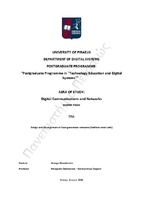| dc.description.abstractEN | The increasing demands for data mobile traffic leads to new challenges for mobile operator and networks in terms of user capacity and data throughput. In order to be able to serve these demands, Heterogeneous Networks (HetNets) consist by macro and small cells have seemed like a promising solution. By adopting a HetNet solution we have more cells in the network, with lower coverage than the ones that already exist, which leads to better user experience for the same area of coverage compared with a macro cell. However, the introduction of more cells also leads to high-complexity scenarios. Thus, it is necessary to create tools that help to mitigate this complexity and be able to help engineers dimensioning the expansion of the network, more efficiently. The study here presented focus on the use of "what if" scenarios for a given traffic load forecast. The results are given in terms of the network user throughputs. They show that in order to serve a huge amount of data at the future, it is better to embraces HetNet solutions instead of upgrading your existing and expensive macro cell network. It is also shown that although more complex, a coordinated architecture does not necessarily lead to a better solution, when using schedulers that try to treat fairly all the users. In this case it is better to apply policy control for the users and assign your users to policy profiles, with this approach a better Quality of Experience for the users will be achieved. With the evolution of mobile networks and the growth of Smartphone's, more and more applications having Quality of Service requirements are coming up. The study of users being classified under a CoS (Class of Service) profile has been also done. Based on the results obtained in this paper through a variety of scenarios and simulations, managing future data traffic and dealing with users that are classified to CoS profiles, in HetNets can be seen as a positive solution. | el |



